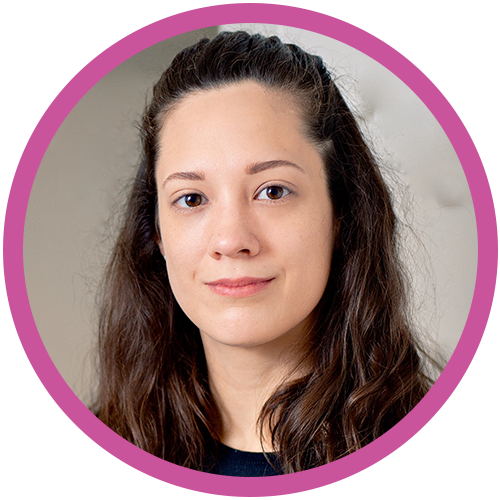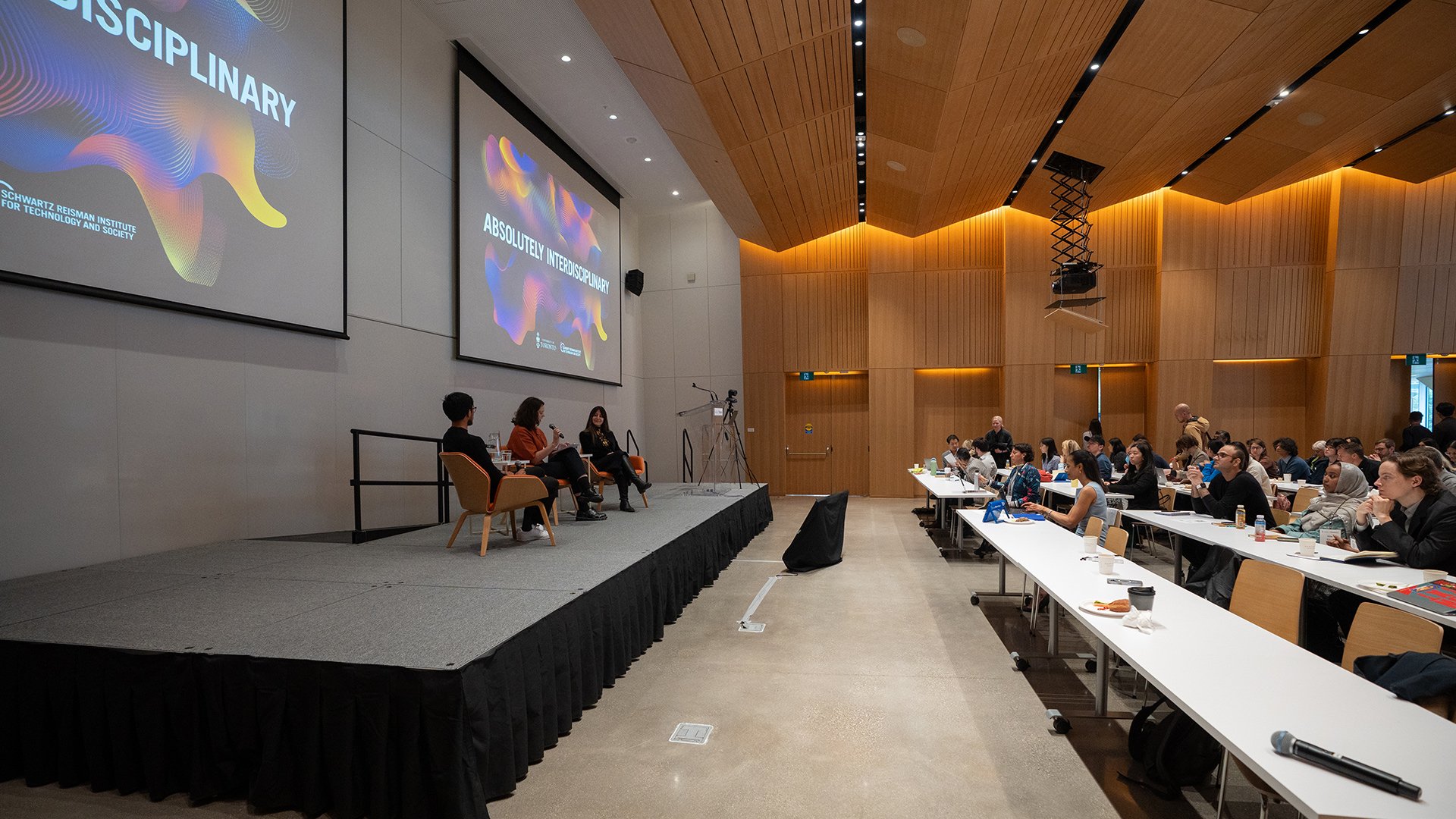Entering the uncanny valley: Technophilosophy September Soirée explores the impacts of VR
How is virtual reality changing the way we live? Does living in a virtual landscape create new ethical and moral problems? At the first annual Technophilosophy September Soirée, SRI Research Lead Karina Vold convened an interdisciplinary panel of University of Toronto scholars to discuss the impacts of new technologies on the way we understand our world.
On stage at Victoria College’s Isabel Bader Theatre on September 19, 2022, Karina Vold, an associate professor at the University of Toronto’s Institute for the History and Philosophy of Science and Technology (IHPST) and research lead at the Schwartz Reisman Institute for Technology and Society, posed a question about virtual reality (VR).
“Right now, we can distinguish virtual reality from what is not VR. But what happens when we cannot?”
Vold was introducing the first Technophilosophy September Soirée, featuring a panel of leading U of T thinkers from a variety of disciplines, including history, philosophy, computer science, design, language and literature, religion, mathematics, cognitive science, art, human-computer interaction, and even cartography. Technophilosophy asks philosophical questions about technology and its uses, and employs technology as a lens to interpret traditional philosophical questions in new ways.
Expected to be an annual event, the well-attended discussion focused on the social and cultural implications of VR and augmented reality (AR) technologies. The genesis for the project was a reading group convened by Vold and her students in the spring and summer that engaged the cognitive philosopher David Chalmers’ Reality+ (2022), and generated extensive debates around many of the book’s unique and alluring claims. As the evening’s discussion made clear, understanding VR’s impacts requires ongoing interrogations from a wide range of disciplines.
Karina Vold
Is virtual reality also reality?
VR technologies have become an instrument through which humans experience new aspects of reality, in an alternative or enhanced way. But is virtual reality—the space of the metaverse that some of us first met when we read Neal Stephenson’s 1992 novel Snow Crash—also real?
For Chalmers, the answer is yes. Not only are virtual worlds real, he contends, but it is possible to live a meaningful life immersed entirely within virtual spaces.
Considering this thesis, Vold and her panelists raised several key questions within their discussion. For a virtual life to be meaningful, would we need to know if we were within a simulation? Would it matter? Should we be informed if the world we are experiencing is virtual?
It’s a question that resembles whether we want to be lucid when dreaming.
Acknowledging that questions about what is real or artificial—and whether such terms overlap—don’t have simple or convenient answers, the panel’s presentations ranged from the uncanny to the amusing—and even delightfully impromptu—at times. And, much to the audience’s reward, the ensuing discussions raised many intriguing, complex, and unresolved questions.
SRI Research Lead Karina Vold introduces the Technophilosophy September Soirée at Isabel Bader Theatre on September 19, 2022. Image courtesy of Karina Vold.
VR as part of everyday life
VR as a site of interdisciplinary encounter doesn’t just shape how we communicate with each other and with our machine interlocutors. Considering its range from fully-simulated worlds to platforms that subtly augment our everyday existence, VR also blurs lines between distinct fields of research, as well as between real space, augmented space, and the metaverse.
PhD candidate Jessie Hall of U of T’s IHPST examined how abstract mathematical models map to physical objects. Reminding the audience that our lives are already largely lived in virtual spaces—with gaming, social media, and Zoom as familiar examples—Hall provocatively asked if we could cleanly delineate between what is virtual and what is not, and the extent to which such distinctions are important.
Karan Singh, a professor in U of T’s Department of Computer Science who develops interactive graphics, commented that what we traditionally call “real” life space might be viewed as virtual reality—augmented by a much, much bigger screen.
Such an irreverently flipped perspective might initially evoke laughter, and the uneasy feeling of the uncanny valley.
Coined by Masahiro Mori in 1970, the term “uncanny valley” refers to a space of uncertainty between the human and the merely humanlike, and to a discomfort that arises when one encounters a representation that seems human, but is in some sense “off.” This unease, however, also offers a sharper perspective upon what specific components complete the illusion of the real within virtual spaces, and which fail to do so.
In asking what is “real” in virtual spaces, we are also seeking to understand the human mind and its relation to computation, noted Brian Cantwell Smith, Reid Hoffman Professor of Artificial Intelligence and the Human at U of T’s Faculty of Information and author of The Promise of Artificial Intelligence: Reckoning and Judgement (2019). “We first need to understand what computation is, and I think computation is representational,” said Smith. However, he noted, “there are things that matter that I cannot represent.”
Artist David Rokeby, associate director of U of T’s BMO Lab who has explored human relationships with machines for 35 years through his seminal new media work, reminded the audience that concepts constructed in the human mind enable us to interpret what arrives through our senses. “In a sense,” said Rokeby, “all reality is already augmented.” While VR presents a setting of relationships deprived of the physical body, it also offers a way to deliberately and purposefully explore ideas that don’t have easy physical representation.
Adrien Zakar, a historian of maps and visual practices who collaborates with builders of virtual spaces, emphasized that VR—whether “real” or not—is an arena in which we can revisit old questions under new “multilingual” conditions. What does language look like in the metaverse? The question is an unresolved inquiry that has been around at least since the term originated in Stephenson’s Snow Crash.
Literature: The O.G. virtual reality
Avery Slater, an assistant professor of English at U of T and a research lead at the Schwartz Reisman Institute whose work explores relations between language and computational technologies, reminded the audience that before there was VR, there was literature. The space of literary imagination, Slater observed, invites readers to experience an alternative reality, and has even launched ideas regarded as “original” to VR. “Literature is the O.G.,” Slater contended. Rather than ask what literature brings to VR, we should pose the question in the other direction.
Stephenson’s Snow Crash is not only visionary as a work of literature—as Slater noted, technologies like Google Earth look like the software used within the novel. On a more sobering note, Stephenson’s metaverse functions in exclusive terms: an escape for the few, rather than an opportunity for all. And, for some who venture virtually in Stephenson’s tale, the experience is literally mind-altering. Does any of this sound familiar within our varied metaverses of today?
From left to right, top to bottom: Technophilosophy September Soirée panelists Jessie Hall, David Rokeby, Karan Singh, Avery Slater, Brian Cantwell Smith, and Adrien Zakar.
Risks and limitations in the virtual landscape
Given VR’s capacity to allow its users to imagine different worlds in which they can fluidly recreate alternative selves, the technology might seem solely like a site of imaginative play and unbounded freedom. But it also carries risk. Slater cautioned how a metaverse in which we create fluid identities of an ever-morphing self is also connected to our real physical bodies which, far from being unbounded, have been mapped to precision on the non-virtual side.
Responding to a question about how life in the metaverse could impact the collection of data, Rokeby observed that total immersive interaction isn’t really distinguishable from total surveillance. If a machine is designed to have regard for how a user feels about a specific issue, belief, or person, this also implies that the machine must know everything about the user that there is to know.
The panel also discussed what can become transparent not just through, but to the machine: what would, or what must remain, beyond the reach of virtual “understanding”? If we decide certain facets of our non-virtual selves should remain invisible to VR tools, would the virtual world of our making become less “real” to us? As Slater noted, certain experiences won’t be built into virtual space: a VR picnic might be free of unpleasant gnats (or I would add, mosquitoes). However, on a thoroughly different level this also risks the erasure of qualities of life that are wonderful and ineffable. Are we in danger of leaving out what we know deeply, yet don’t quite have words for?
Expressing concern about virtual worlds characterized by “excessive positive feedback,” Rokeby cautioned that we are in danger of leaving out what is challenging or unpleasant. In a setting in which it becomes rational to adapt “in a sense that overrides the sensible,” he noted one can start to believe in actions of self-harm that are successfully disguised as rewards. Singh ventured that reality co-processing appeared as a milder version of this: Google Maps does not take you where you are going, but instead tells you how to get there. Would it be rational, then, to never learn how to arrive at all? While the wheels or knobs on a VR flight simulator offer the illusion of navigating, is the human reaching for them really learning to fly?
What residues of virtual life and kinesthetic memories carry us back to non-virtual spaces? What does it mean to go back and forth and exist in both versions of “real”? And—as Rokeby intriguingly asked—if VR is so amazing, why didn’t it take off during the pandemic?
This brings us back to one of Vold’s initial questions: if we’re in a simulated world, would we want to know? The answer would, I imagine, depend upon what that world is like.
The visions of how to build virtual worlds continue to stir the field of technophilosophy and generate new discussions. As technology makes possible a dynamic, and—at least virtually—real means by which humans can both succeed and fail to learn and communicate, new questions about the possibilities and limits of realities—in the plural—will inevitably proliferate.
Technophilosophy September Soirée was co-sponsored by the Schwartz Reisman Institute, the Institute for the History and Philosophy of Science and Technology, Centre for Ethics, Victoria College, Faculty of Arts & Science, and BMO Lab at the University of Toronto.
Want to learn more?
About the author
Anne-Marie Fowler is a PhD candidate in the University of Toronto’s Department for the Study of Religion in collaboration with the Anne Tanenbaum Centre for Jewish Studies, and a 2022–23 Schwartz Reisman Graduate Fellow. Her work leverages philosophies of science, time and infinity in proposing AI ethics as a function of the ongoing learning, anticipation and construction of knowledge. Fowler has been a graduate research fellow at the University of Toronto’s Centre for Ethics and is a junior fellow at Massey College. Prior to coming to Toronto in 2019 from her home city of San Francisco, Fowler’s master’s degree integrated social ethics, political economics and systems of global debt to evaluate how sovereign debt systems might leverage evolving technologies toward more effective and just outcomes. She has worked in banking and portfolio management and has engaged research and policy advisory around the U.S. Treasury, U.S. Federal Reserve and global debt systems. A start-up co-founder and advisor with particular interest in political and elections-related data science, Fowler has also been active as a public-private project coordinator in areas of community broadband and digital equity, and has fundraised on a national level in support of U.S. graduate students of diverse and underrepresented backgrounds pursuing degrees in STEM fields.












